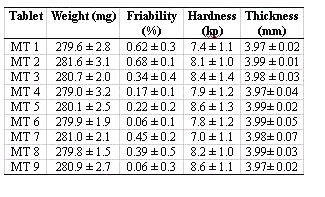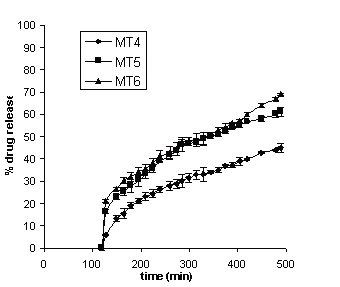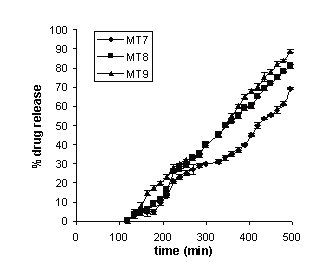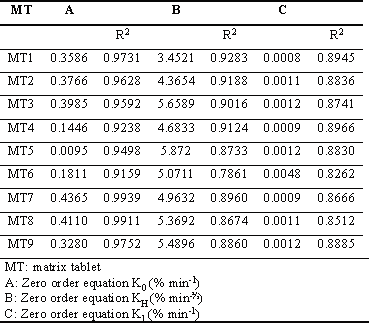J Pharm Pharmaceut Sci (www.ualberta.ca/~csps) 5(3):213-219, 2002
In-vitro studies of diclofenac sodium controlled-release from biopolymeric hydrophilic matrices.
Silvina A. Bravo, Maria C. Lamas, Claudio J. Salomón1
Department of Pharmacy. Faculty of Biochemical and Pharmaceutical Sciences. National University of Rosario. Argentina, and IQUIOS-CONICET, Rosario. ArgentinaReceived 12 February 2002, Revised 08 July 2002, Accepted 26 August 2002
PDF version
Abstract
PURPOSE: The objective of this study was to develop uncoated HPMC matrix tablets, evaluating the relationship and influence of different content levels of microcrystalline cellulose (MCC), starch, and lactose, in order to achieve a zero-order release of Diclofenac Sodium. METHODS: HPMC matrix tablets of Diclofenac Sodium using microcrystalline cellulose (MCC), starch, and lactose were prepared by wet granulation process. The USP paddle method was selected to perform the dissolution profiles carried out in 900 mL 0.1 N HCl, and phosphate buffer. RESULTS: There was no significant difference in drug release between the hydrophilic matrices when the HPMC concentration was modified in low percentage. Release kinetics of Diclofenac Sodium from these swollen matrices was principally regulated by starch (17 percent) or lactose (17 percent), even on the presence of MCC. When starch (8.5 percent) and lactose (8.5 percent) were mixed at lower concentration in a ratio 1:1, MCC (5 percent or 7,5 percent) appeared to control the drug release. The release profile remained unchanged after three months storage of tablets. The best-fit release kinetics was achieved with the zero-order plot, followed by the Higuchi and first-order equations. The data obtained proved that the formulations are useful for a sustained release of Diclofenac, due to the percentage released after 8 hours is nearly to 70 percent. CONCLUSIONS: The release of Diclofenac Sodium was influenced by the presence of MCC, and by the different concentrations of starch and lactose. Drug release kinetics from these formulations corresponded best to the zero-order kinetics. Compared to conventional tablets, release of the model drug from these HPMC matrix tablets was prolonged; as a result, an oral release dosage form to avoid the gastrointestinal adverse effects was achieved.
Introduction
Hydrophilic matrices containing swellable polymers are referred to as hydrogel matrices, swellable controlled-release systems or hydrophilic matrix tablets. A number of polymers have been investigated to develop in situ gel-forming systems, due to the ability of these hydrogels to release an entrapped drug in aqueous medium and to regulate the release of such drug by control of swelling and cross-linking (1,2,3).
These systems draw attention in the search for improved patient compliance and decreased incidence of adverse drug reactions. Under ideal conditions, a sustained-release formulation maintains therapeutic blood level of a drug for a specific period of time. Oral controlled-release dosage forms have been developed and studied to restrict these systems to specific regions of the gastrointestinal tract as well as to improve the pharmacological activity and to reduce toxic effects (4). One method of fabricating controlled-release formulations is by the incorporation of the drug in a matrix containing a hydrophilic, rate-controlling polymer (5,6). Hydroxypropylmethylcellulose (HPMC) is the polymer most widely used as the gel-forming agent in the formulation of solid, liquid, semisolid and even controlled-release dosage forms. Water penetration, polymer swelling, drug dissolution, drug diffusion and matrix erosion from these dosage forms are controlled by the hydration of HPMC, which forms a gel barrier through which the drug diffuses (7,8). The adjustment of the polymer concentration, the viscosity grade and the addition of different types and levels of excipients to the HPMC matrix can modify the drug release rate. The importance of the diffusion layer for a swollen HPMC matrix was illustrated in a mathematical model (9). In addition, the influence of technological variables on drug release from HPMC matrices was reviewed by Vazquez et al (10). Vyas et al reported the influence of high viscosity grade of HPMC on the drug release from matrix tablets (11).
Numerous studies have been carried out in order to achieve a desirable release rate of several non-steroidal anti-inflammatory drugs to treat rheumatoid arthritis, and osteoarthritis. (12). Recently, Davies published an interesting review based on the important clinical concern when NSAIDs are prescribed (13).
Diclofenac Sodium, one of the most useful NSAIDs agent, it is a practically insoluble compound in acidic solution (pK a =4.0), but dissolves in intestinal fluid and water. In order to eliminate the gastrointestinal adverse effect of this drug, several swellable controlled-release pharmaceutical dosage forms have been developed. The influence of Diclofenac Sodium:HPMC ratio, particle size of the drug, particle size of the polymer and compression force, on drug release from HPMC matrices was evaluated by Velasco et al showing that the rate and mechanism of drug release are mainly controlled by the drug: HPMC ratio (14). Nokhodchi et al. described that a prolonged release of Diclofenac Sodium from HMPC and ethylcellulose matrices containing a large amount of lactose did not provide zero-order release. In this case, increasing the HPMC concentration resulted in an increase in the release rate of Diclofenac Sodium (15). In addition, it was reported that a matrix material based on Eudragit NE40D was evaluated for preparing release tablets of Diclofenac Sodium (16). In another study, five matrix-tablet formulations were prepared by granulating two viscosity grades of HPMC, and in-vitro/in-vivo correlations of Diclofenac Sodium release systems were investigated. The sustained release ability of the formulations was demonstrated in an in-vivo study, showing the presence of the drug in plasma for about 14 h (17).
Despite the influence of some technological variables have been already described, one goal of this study was to develop uncoated HPMC matrix tablets by the wet granulation process, evaluating the relationship and influence of co-excipients. Microcrystalline cellulose (MCC) and starch were chosen as release modifiers, and lactose as water-soluble diluent. Another objective of this study was to attempt to achieve a zero-order release of the model drug from these uncoated HPMC matrices.
Materials and Methods
Materials
Diclofenac Sodium was purchased from Profarmaco Milan, Italy. Hydroxypropylmethylcellulose (Methocel K15M) was supplied by Dow Chemicals, Miami, U.S.A. The viscosity of 2% HPMC aqueous solution is 0.05 Pa.s. Microcrystalline cellulose (Avicel pH 101) was obtained from FMC Corp., Philadelphia, U.S.A. Lactose was purchased from Foremost Whey Products, Div. Wisconsin Dairies, U.S.A. Polyvinylpyrrolidone (PVP) with molecular weight of 35,000 was purchased from Merck, Germany. All other reagents were analytical or pharmaceutical grade.
Preparation and characterization of matrix tablets
The detailed compositions of HPMC matrix tablet formulations are given in Table 1.
Table 1: Composition (in mg) of 50-mg Diclofenac Sodium matrix tablets.
HPMC, at different ratios was blended with the Diclofenac Sodium, microcrystalline cellulose (MCC), starch and/or lactose, in a planetary mixer for 5 minutes. Thereafter, the powders were granulated with 10% w/v PVP/EtOH solution, sieved using a N° 14 mesh screen, and the granules obtained dried in a hot air oven at 40°C for 3 hours. Finally, the granules were dried and sieved using a N° 12 mesh screen before tableting. Tablets of approximately 280 mg weight each were prepared from these granules after addition of starch (4%) and magnesium stearate (3.5%). Tablets were compressed using a single punch-tableting machine Erweka, Heusenstamm-Germany, with 9 mm flat round punches. Three batches were prepared for each formulation. The physical properties of the biopolymeric matrix tablets are given in Table 2. The weight variation of the tablets was evaluated on 20 tablets using an electronic balance (Ohaus TS120S). The flow properties were measured by the angle of repose f. Friability was determined using 6 g of tablets in a Roche friabilator for 4 min. at a speed of 25 rpm. For each formulation the hardness of 10 tablets was also evaluated using an ERWEKA TBT 28 apparatus (Erweka GmbH, Germany).
Table 2: Physical properties of Diclofenac Sodium matrix tablets.
The tablet hardness ranged from 7 to 9 Kp. The thickness of the tablets was measured on 10 tablets with a Vernier Calipter (Mitutoyo, Japan).
In Vitro Drug Dissolution Studies
Drug release profiles were evaluated in vitro using a dissolution test apparatus (Hanson Research, SR8 8-Flask Bath). The USP paddle method was selected to perform the dissolution profiles of Diclofenac Sodium from HPMC. The same test for all the formulations was carried out in 900 mL 0.1 N HCl, and phosphate buffer, (USP XXIV) maintained at 37 ± 0.5°C at a paddle rotation speed of 50 rpm. Withdrawing 5 mL filtered samples at preselected intervals up to 8 hours monitored progress of the dissolution. The release rates from these hydrophilic polymeric matrices were conducted in a medium of changing pH by starting with a tablet in HCl solution (pH=1,2) for 2 hours. Then, the tablets were immersed into a phosphate buffer (pH=6.8) for 6 hours. The sample solutions were analyzed for Diclofenac Sodium by UV absorbance at 276 nm using a Spectrophotometer Unicam (UV-Vis, Peltier 178). Cumulative percentage of drug release was calculated and the mean of three determinations was used in data analysis.
Release Kinetics
To study the mechanism of drug release from the matrix tablets, the release date were fitted to the following equations:
Zero-order equation: Q = Q0-k0t (1)
where Q is the amount of drug release at time t, and k0 is the release rate;
First-order equation: ln Q = ln Q0 - k1t (2)
where k1 is the release rate constant;
Higuchi´s equation: Q = k2t1/2 (3)
Where Q is the amount of drug release at time t, and k 2 is the diffusion rate constant.
Stability study
A stability test was conducted by storing tablets in amber bottles at ambient temperature, 40°C, and 50°C. The content of DS and the dissolution of drug from these matrix tablets were tested monthly for three months. The assay of DS and the dissolution study followed the same procedure as previously described.
RESULTS AND DISCUSSION
Physical characterization of the matrix tablets
Tablets diameter, friability, thickness, hardness and weight of the formulated tablets are described in Table 2. The weight deviation of the nine matrix tablets was acceptable due to the granule flowability properties. The flow characteristics were improved by adding starch, as a glidant, to the granular mixture. Three differents concentration of starch were used (1.5%, 3%, and 4%), and, it was found that optimum concentration of the glidant was 4%. The minimal friability obtained confirmed the suitability of the wet-granulation technology for the preparation of these HPMC matrices.
Influence of pH
It is known that the release rate of drugs from hydrophilic matrices containing HPMC, is affected by changing the pH. Thus, the dissolution rate was investigated at pH 1.2 and 6.8. For all the formulations, the release rate of Diclofenac Sodium was extremely low at acidic pH, since after 2 hours only less than 1% of drug was released, spectrophotometrically observed. All the batches described in this work displays a similar behavior at pH 6.8, showing a faster drug dissolution rates, in agreement with previous studies (15).
Influence of starch
Starch is water swellable by nature. The presence of starch in an HPMC matrix tablet could modified the release rate, due to the disintegration phenomenon is based on the fast water uptake, followed by the HPMC swelling (18). Thus, the comparative influence of the co-excipients starch and MCC as release modifiers was evaluated. Figure 1 shows plot of the cumulative amount of drug released against time for the formulations MT1, MT2 and MT3.
Figure 1: Mean (±s.d.) percent of Diclofenac Sodium released from HPMC matrix tablets (n = 3), containing 17% of starch in dissolution study at pH = 1.2 and pH = 6.8.
It was observed that the different concentrations of HPMC on the drug release rate were not significant, due to the similar behavior of the three formulations under the same dissolution conditions. In this case, small variations on the HPMC concentration would not affect the profile release of the model drug, despite of another study where was reported that the increase of HPMC content with the same drug concentration resulted in a decreased release rate of drugs (19). The results obtained herein show clearly that the drug released at 8 h of the batch MT1 (0% MCC-17% starch) was slightly higher, compared with the batches MT2 (5% MCC-17% starch) and MT3 (7,5% MCC-17% starch), indicating that MCC did not produce any relevant effect on the drug release rate. We assume, in this particular case, that MCC works as diluent creating the desired bulk as well as giving the right compression characteristics (20). Thus, release rate of Diclofenac Sodium from MT1, MT2, and MT3 would be mainly controlled by the hydration and swelling properties of HPMC and starch, which forms a gel layer that controls the water penetration and drug diffusion.
Influence of lactose
Lactose is the most useful filler used for tablet formulations. It is water-soluble and would modify the drug release for undergoing dissolution. Drug release from the tablets compressed with Diclofenac, HPMC, lactose and MCC, are shown in Fig. 2.
Figure 2: Mean (±s.d.) percent of Diclofenac Sodium released from HPMC matrix tablets (n = 3), containing 17% of lactose in dissolution study at pH = 1.2 and pH = 6.8
While the batch MT4 (0% MCC-17% lactose), decreased the drug release too much (45% after 8 h), when MCC was incorporated in the formulations MT5 (5% MCC-17% lactose), and MT6 (7.5% MCC-17% lactose), the release rate was markedly increased up to 70%, compared to a MT4 tablet without MCC. In this case, the swelling behavior of MCC allowed further penetration of the aqueous medium, resulting in rapid erosion of the polymer matrices. In addition, lactose in aqueous solution plays a role as important physical barrier, affecting the release kinetics, by reducing the tortuosity of the diffusion pattern of the drug (21). However, if it were mixed with HPMC, the polymer concentration would lead the release rate of the drug. Thus, it was expected that decreasing the HPMC concentration, being constant the lactose concentration could increase the release rate of Diclofenac, as shown in Fig. 2.
Influence of lactose:starch mixture
The last three batches MT7, MT8 and MT9 were formulated by mixing lactose and starch in a 1:1 ratio, having on mind that each excipient by itself modified the release rate of the drug, in agreement with the results described in Fig. 1 and Fig. 2. Fig. 3 depicts the release profile of MT7 (0% MCC-8.5% starch-8.5% lactose), MT8 (5% MCC-8.5% starch-8.5% lactose), and MT9 (7.5% MCC-8.5% starch-8.5% lactose).
Figure 3: Mean (±s.d.) percent of Diclofenac Sodium released from HPMC matrix tablets (n = 3), containing 8.5 % of starch and 8.5 % of lactose in dissolution study at pH = 1.2 and pH = 6.8
The percentage of drug released at 8 hr from MT8 and MT9 matrices was more than 80% and 90%, while the percentage drug release from MT7 matrix was less than 70%; clearly showing that in this particular case the presence of MCC plays an important role as a filler as well as a release modifier. (22,23). These tablets containing a 50% less of starch and a 50% less of lactose showed a higher release rate of Diclofenac, compare with the matrix tablets formulated only with starch (MT1-MT3) or lactose (MT4-MT6). By this observation, we can conclude that lowering the amount of starch; it was enough to produce the dissolution process on a very good controlled-release rate. Moreover, decreasing the amount of lactose, did not affect the path diffusion of the drug, due to the good release kinetic obtained.
Drug Release Kinetics
In Table 3, the kinetic parameters for Diclofenac Sodium release from these HPMC matrix tablets (MT1-MT9) are presented.
Table 3: Kinetic parameters of Diclofenac Sodium release from the matrix tablets.
Dissolution data fit a zero-order kinetics, despite of quite high correlation coefficients were obtained with other kinetic models.
Lot reproducibility and stability test
Three batches of each formulation were prepared and the dissolution rate of DS was evaluated under the same conditions. The resulting release profiles of DS from these three different batches of each matrix formulation (MT 1-MT 8) showed no significant difference among the release profiles for each set of three batches, indicating that this manufacturing process is reliable and reproducible.
The stability of DS in these matrix tablets was evaluated over three months at three different temperatures. There was no physical change in the tablets, moreover, there was insignificant DS degradation in the eight formulated tablets, suggesting that the drug is stable in the HPMC tablets (Fig. 4). Apparently, the drug release from these matrices does not change after storage for this period of time.
Figure 4: Mean (±s.d.) percent of Diclofenac Sodium released from HPMC matrix tablets (n = 3), containing 8.5 % of starch and 8.5 % of lactose stored at 25 ° C, 40 ° C, and 50 ° C.
CONCLUSIONS
Diclofenac Sodium release matrices were prepared successfully utilizing HPMC as a carrier. From the technological point of view, the wet granulation method enables the preparation of these matrices. The physical properties described in Table 2 were found to be optimal for the manufacturing process. It was observed that free-flowing powders (a minimum angle of repose ø) were obtained by using starch in a 4% concentration as a glidant. There was no significant difference in drug release between the hydrophilic matrices when the HPMC concentration was modified in low percentage. Drug release from swollen matrices was principally regulated by starch (17%) or lactose (17%), even on the presence of MCC at different levels (5% or 7.5%). However, when starch (8.5%) and lactose (8.5%) were mixed at lower concentration in a ratio 1:1, MCC (5% or 7,5%) appeared to control the drug release from the matrices. Clearly, each of these components was capable of interacting to some extent with each other to control drug release. The best-fit release kinetics with the highest correlation coefficients was achieved with the zero-order plot, followed by the Higuchi and first-order equations, respectively, over 8 h. Compared to conventional tablets, release of Diclofenac Sodium from these release HPMC matrices was prolonged. The data described in Fig. 1, 2, and 3 proved that the formulations are useful for a sustained release of Diclofenac, due to the percentage released after 8 h is nearly to 70%, except the MT4 and MT5 matrix tablets. The formulations were not affected when subjected to different stability conditions. The release profile remained unchanged after three months storage of tablets. The results obtained herein were in agreement with a recently report describing the release rates of marketed Diclofenac Sodium sustained-release tablets (24).
ACKNOWLEDGMENTS
C.J.S. is very grateful to Fundación Antorchas (Argentina), and National Research Council (CONICET-Argentina) for partial support. The authors wish to thank the Faculty of Biochemical and Pharmaceutical Sciences, National University of Rosario for equipment (FOMEC grant) and financial support. The authors are indebted to Prof. Kurt Bauer (Freiburg, Germany) for his interest in this work.
Krowczynsky, L.; Extended-Release Dosage Forms, CRC Press, Boca Raton, FL, 1987.
Chien, Y.W.; Novel Drug Delivery Systems, 2nd ed., Marcel Dekker, New York, 1992.
Ravi Kumar, M.N.V.; Kumar, N. Polymeric Controlled Drug-Delivery Systems: Perspectives Issues and Opportunities. Drug Dev. Ind. Pharm, 27:1-30, 2001
Roseman, T.J.; Cardinelli, N.F.; in Controlled-release Technologies, Vol. 1 (A. F. Kydonieus, ed), CRC Press, Boca Raton, FL, 1980.
Veiga, F.; Salsa, T.; Pina, E. Oral Controlled-release Dosage Forms. II. Glassy Polymers in Hydrophilic Matrices. Drug Dev Ind Pharm, 24:1-9, 1988.
Colombo, P. Swelling-Controlled-release in Hydrogel Matrices for Oral Route. Adv Drug Del Rev, 11:37-57, 1993.
Sung, K.C.; Nixon, P.R.; Skoug, J.W.; Ju, T.R.; Gao, P.; Topp, E.M.; Patel, M.V. Effect of Formulation Variables on Drug and Polymer Release from HPMC-Base Matrix Tablets. Int J Pharm, 142:53-60, 1996.
Siepmann, J.; Kranz, H.; Bodmeier, R. HPMC-Matrices for Controlled Drug Delivery: A New Model Combining Diffusion, Swelling, and Dissolution Mechanisms and Predicting the Release Kinetics. Pharm Res, 16:1748-1756, 1999.
Ford, J.L.; Mitchell, K.; Rowe, P.; Armstrong, D.J.; Elliot, P.N.C.; Rostron, C.; Hogan, J.E. Mathematical Modeling of Drug Release from Hydroxypropylmethylcellulose Matrices: Effect of the Temperature. Int J Pharm, 71:95-104, 1991.
Vazquez, M.J.; Perez-Marcos, B.; Gomez-Amoza, J.L.; Martinez-Pacheco, R.; Souto, C.; Concheiro, A. Influence of Technological Variables on Release of Drugs from Hydrophilic Matrices. Drug Dev Ind Pharm, 18:1355-1375, 1992.
11.-Vyas, S.P.; Jain, N.K.; Khana, S. Formulation and Performance Evaluation of Controlled-release Diclofenac SodiumTablets. J Control Rel, 10:219-223, 1989.
12.-Todd, P.A.; Sorkin, E.M. Diclofenac Sodium; a Reappraisal of its Pharmacodynamic and Pharmacokinetics Properties, and Therapeutic Efficacy. Drugs 35:244-285, 1988
13.-Davies, N.M. Sustained Release and Enteric Coated NSAIDs: Are They Really GI Safe? J Pharm Pharmaceut Sci, 2:5-14,1999
14.-Velasco, M.; Ford, J., Rowe, P. Influence of Drug: Hydroxypropylmethylcellulose Ratio, Drug and Polymer Particle Size and Compression Force on the Release of Diclofenac Sodium from HPMC Tablets. J Control Rel, 57:75-85, 1999.
Nokhodchi, A.; Farid, D.; Najafi, M.; Adrangui, M. Studies on Controlled-release Formulations of Diclofenac Sodium. Drug Dev Ind Pharm, 23:1019-1023, 1997.
Billa, N.; Yuen, K.D.; Peh, K. Diclofenac Sodium Release from Eudragit Containing Matrices and Effects of Thermal Treatment. Drug Dev Ind Pharm, 24:45-50, 1998.
Liu, C-H., Kao, Y-H., Chen, S-C.; Sokoloski, T.D.; Sheu, M-T. In Vitro and In Vivo Studies of the Diclofenac Sodium Release Matrix Tablets. J Pharm Pharmacol, 47:360-364, 1995.
Carstensen, J.T. Pharmaceutics of Solids and Solid Dosage Forms, John Wiley and Sons, New York, 1977.
Shah, N.; Zhang, G.; Apelian, V.; Zeng, F.; Infeld, M.H.; Malick, A.W. Prediction of Drug Release from Hydroxypropyl Methylcellulose (HPMC) Matrices: Effect of Polymer Concentration. Pharm Res, 10:1693-1695, 1993.
Refoio, M. In Encyclo Polym Sci Tech, Suppl. 1, 214, 1976.
Gao, P.; Nixon, P.; Skoug, J. Diffusion in HPMC gels. II. Prediction of Drug Release Rates from Hydrophilic Matrix Extended-release Dosage Forms. Pharm Res, 12:965-971, 1995.
Lee, B-J.; Ryu, S-G.; Cui, J-H. Formulation and Release Characteristics of Hydroxypropyl Methylcellulose Matrix Tablet Containing Melatonin. Drug Dev Ind Pharm, 25:493-501, 1999.
Kader, A., Jalil, R. Formulation Factors Affecting Drug Release from Poly(Lactic Acid) (PLA) Microcapsule Tablets. Drug Dev Ind Pharm, 25:141-151, 1999
Madhusudan Rao, Y.; Krishna Veni, J.; Jayasagar, G. Formulation and Evaluation of Diclofenac Sodium Using Hydrophilic Matrices. Drug Dev Ind Pharm, 27:759-766, 2001.
Corresponding Author: Claudio J. Salomón, Department of Pharmacy, Faculty of Biochemical and Pharmaceutical Sciences, National University of Rosario, Suipacha 531, 2000, Rosario, Argentina. csalomon@fbioyf.unr.edu.ar
Published by the Canadian Society for Pharmaceutical Sciences.
Copyright © 1998 by the Canadian Society for Pharmaceutical Sciences.
http://www.ualberta.ca/~csps







